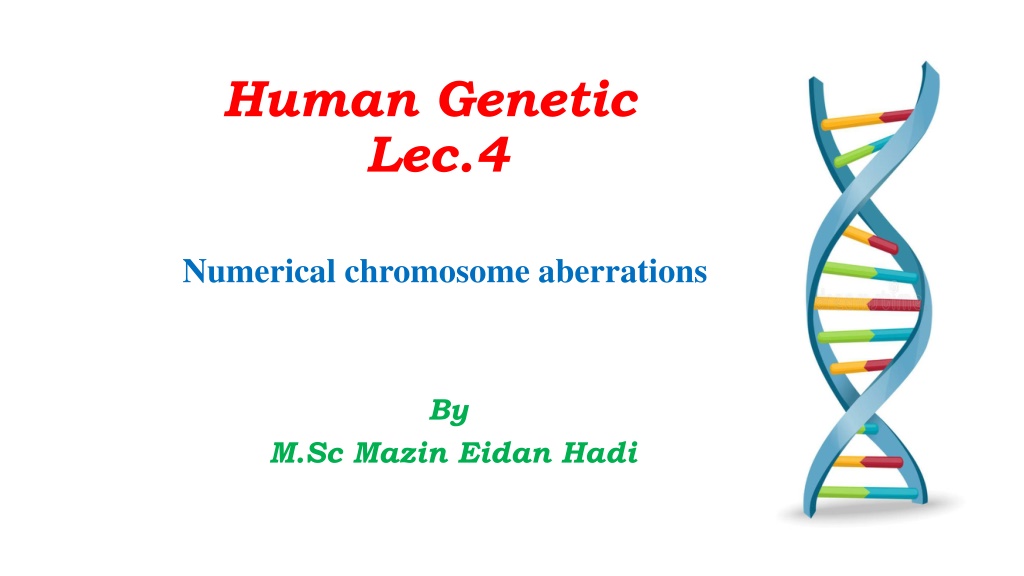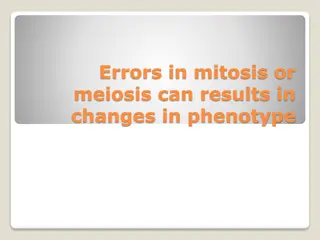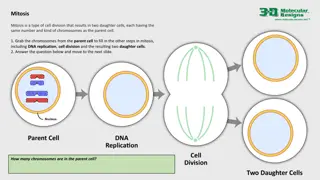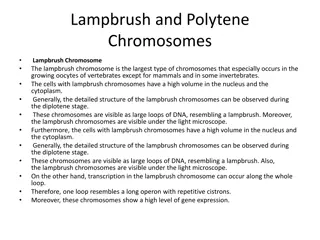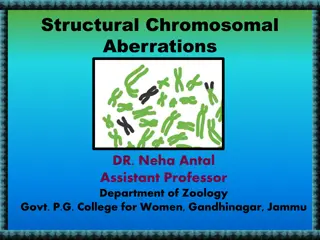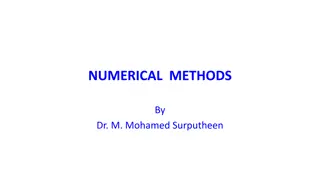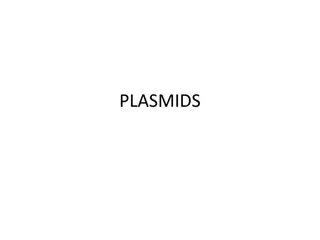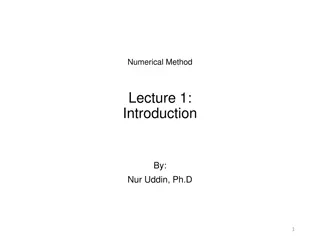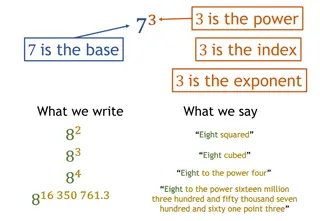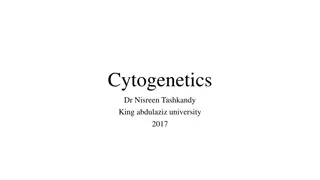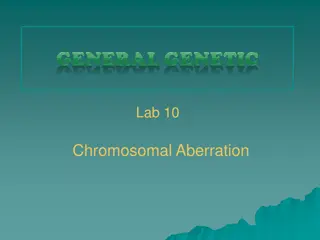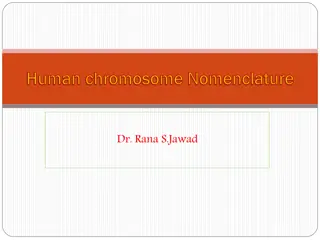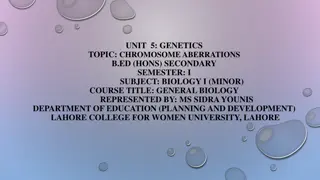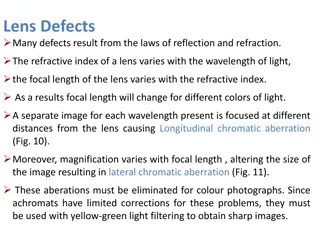Understanding Numerical Chromosome Aberrations in Humans
Numerical chromosome aberrations involve the gain or loss of whole chromosomes, impacting the genome size and potentially leading to genetic mutations. Nondisjunction, where chromosomes fail to separate properly during cell division, can result in aneuploidy - the presence of an extra or missing chromosome. Trisomies such as Down syndrome (Trisomy 21), Patau syndrome (Trisomy 13), and Edwards syndrome (Trisomy 18) are examples of numerical chromosomal abnormalities with varying frequencies and outcomes. These aberrations can lead to pregnancy loss, emphasizing the critical role of chromosomal abnormalities in human genetics.
Download Presentation

Please find below an Image/Link to download the presentation.
The content on the website is provided AS IS for your information and personal use only. It may not be sold, licensed, or shared on other websites without obtaining consent from the author. Download presentation by click this link. If you encounter any issues during the download, it is possible that the publisher has removed the file from their server.
E N D
Presentation Transcript
Human Genetic Lec.4 Numerical chromosome aberrations By M.Sc Mazin Eidan Hadi
Numerical chromosome aberrations Are defined as a gain or loss of one or more whole chromosome(s) (whether an autosome or a sex chromosome) or a whole set of chromosomes. The normal chromosome count is 46 (i.e. 2n = 46) as it is arranged in two sets of chromosomes. The numerical abnomalies, when one or more chromosomes are in excess or missing, ultimately modify the entire genome size, so they can be considered genome mutations as well. Nondisjunction - Mistake in cell division where chromosomes do not separate properly in anaphase. Usually in meiosis, although in mitosis occasionally. In meiosis, can occur in anaphase I or II. Polyploidy complete extra sets (3n, etc.) fatal in humans, most animals.
Numerical chromosome aberrations Aneuploidy missing one copy or have an extra copy of a single chromosome. Three copies of a chromosome in your somatic cells: Trisomy. One copy of a chromosome in your somatic cells: monosomies are lethal well before birth in humans. Monosomy Most trisomies and Generally, autosomal aneuploids tend to be spontaneously aborted. Over 1/5 of human pregnancies are lost spontaneously after implantation. Chromosomal abnormalities are the leading known cause of pregnancy loss. Data indicate that minimum 10-15% of conceptions have a chromosomal abnormality. At least 95% of these conceptions spontaneously abort (often without being noticed.
The most common numerical chromosomal abnormalities 1- chromosome disorder autosomes Abnormalities occur in autosomes .There are three trisomies that results in baby which can survive for time after birth ; the other are too devastating and baby usually dies in utero. A- Down syndrome (Trisomy 21) Trisomy 21 is the cause of Down syndrome. Although the non-disjunction of chromosome 21 is not the only cause of Down syndrome -a smaller proportion of the cases is due to either centric fusion or translocation - it is the most common type. Despite the fact that trisomy 21 fetuses die in utero the average population frequency of Down syndrome is 1:650, but this value increases dramatically with maternal age, at 45 years of age it is more than 1:100.
1- chromosome disorder autosomes B-Patau syndrome (Trisomy 13) Trisomy 13 is the Patau syndrome. 65% of such non-disjunctions derived from the first meiotic division. Frequency of birth is 1:12,500 - 1:21,700. Only <5% of these infants survive the first year of life
1- chromosome disorder autosomes C-Edwards syndrome.( Trisomy 18) Trisomy 18 is the Edwards syndrome. It is primarily due to maternal non-disjunction. 95%! of the cases are due to non-disjunction in the first meiotic division. The frequency is 1:6000 -1:10000 live-born but the frequency at the time of conception can be much higher, since approx. 95% of the fetuses die within the womb. 30% of the Edwards syndromic abnormal newborns die within one month, > 95% of them die within a year
2 chromosome disorder of sex chromosome A.Turner syndrome Turner syndrome is related to the X chromosome, which is one of the two sex chromosomes. People typically have two sex chromosomes in each cell: females have two X chromosomes, while males have one X chromosome and one Y chromosome. Turner syndrome results when one normal X chromosome is present in a female's cells and the other sex chromosome is missing or structurally altered. The missing genetic material affects development before and after birth. About half of individuals with Turner syndrome have monosomy X, which means eachcell in the individual's body has only one copy of the X chromosome instead of the usual two sex chromosomes.
2 chromosome disorder of sex chromosome A.Turner syndrome Turner syndrome can also occur if one of the sex chromosomes is partially missing or rearranged rather than completely absent. Some women with Turner syndrome have a chromosomal change in only some of their cells, which is known as mosaicism. Women with Turner syndrome caused by X chromosome mosaicism are said to have mosaic Turner syndrome. The main symptom of Turner syndrome is short stature, grow more slowly than their peers during childhood and adolescence, have small ovaries, don't make enough sex hormones and low hairline at the back of the neck.
2 chromosome disorder of sex chromosome B- XXY male (Klinefelter syndrome) Klinefelter syndrome (KS) is a genetic condition where there s an extra X chromosome present in a male s genetic code. Instead of having a total of 46 chromosomes, they have 47 with two copies of the X chromosome and one copy of the Y chromosome (47,XXY). Klinefelter syndrome can be caused by: One extra copy of the X chromosome in each cell (XXY), the most common cause. An extra X chromosome in some of the cells (mosaic Klinefelter syndrome), with fewer symptoms. More than one extra copy of the X chromosome, which is rare and results in a severe form.
2 chromosome disorder of sex chromosome B- XXY male (Klinefelter syndrome) Signs and symptoms may include: Taller than average stature; Longer legs; shorter torso and broader hips compared with other boys; After puberty, less muscle and less facial and body hair compared with other teens and Small; firm testicles.
2 chromosome disorder of sex chromosome C-XYY male (XYY syndrome) "superman" or Jacobs syndrome In this case normal, slightly taller than the average males have 47,XYY karyotype. The birth rate is 1:1000. They derived only from paternal second meiotic non- disjunction. In contrast to all meiotic non-disjunctions, the formation is not affected by age. Usually tall, with heavy acne; some correlation with mild mental retardation and with aggressiveness; usually still fertile.
2 chromosome disorder of sex chromosome D- XXX female (triple X syndrome) Triple X syndrome can also be referred to as trisomy X syndrome or 47,XXX. Triple X syndrome happens when a female is born with an extra X chromosome, and therefore has a total of 47 chromosomes. For some girls and women with triple X syndrome, all of their cells contain three X chromosomes. In other females with triple X syndrome, some cells have three X chromosomes while other have the usual two X chromosomes this is referred to as mosaicism. The degree of mosaicism (the number of cells with three X chromosomes) may vary from a small percentage to close to 100%.
2 chromosome disorder of sex chromosome D- XXX female (triple X syndrome) The condition occurs in about one out of every 1,000 female births. There is a great degree of variation among girls and women with triple X syndrome. Some individuals do not experience any symptoms or their symptoms are so mild that they go unnoticed. Symptoms may be more pronounced in females with a higher percentage of cells with three X chromosomes. One consistent physical characteristic is that females with triple X are taller than girls of the same age, wide-spaced eyes (known as hypertelorism), poor muscle tone (known as hypotonia) and dysfunction and/or failure of the ovaries, which can be associated with fertility problems.
Mixoploid mutations In mixoploidy or in mutations associated with mixed ploidity usually two (sometimes more) cell lines with different chromosome numbers are found within an organism. There are two forms: mosaicism and chimerism. In the case of gonadal mosaicism only the cells in the germ line have abnormal chromosome number, thus the risk of numerical aberrations in the offspring is high. Unfortunately, the detection of such defects is still not possible routinely, but the birth of an abnormal offspring of the patient can indicate this. Mosaicism in a broader sense is a somatic mutation, when different mutants (alleles) of a given gene are located in different organs or in different cells of the same organ (for example eyes with different colors: one is blue and the other is brown or a blue eye with brown spots).
Mixoploid mutations A chimera is derived either from fusion of fraternal twins, or from double fertilization of an egg and a polar body (polocyte), or from transplacental haematopoietic stem cells exchange between fraternal twins (blood group chimerism). Recently, the chimera referred to as transgenic animals / plants, which contain cells of different origin, derived from either the fusion of few-cell-embryos, or via the microinjection of foreign genes into fertilized oocytes.
Uniparental disomy (UPD) This abnormality which is not or hardly identifiable by cytogenetic methods were recognized - due to molecular biological techniques - in the past decades. The UPD means that the person concerned has a normal chromosome number, but the homologues of a certain chromosome in contrast to normal - are from the same parent, either from the father or from the mother. As for the formation two consecutive numerical aberrations are in the background: a meiotic non-disjunction and an anaphase lag occurring during the early cleavage divisions. The phenotypic result of UPD varies according to the chromosome involved, the parent who contributed the chromosomes, and whether it is isodisomy or heterodisomy. The different symptoms in some of the Prader-Willi and Angelman syndrome cases are not due to the 15q deletion, but the UDP.
